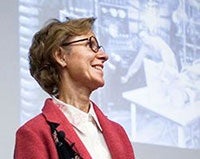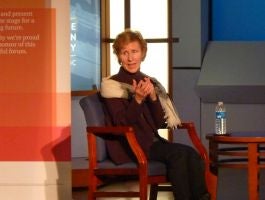
Laird speaking at a fall Mini School for the Humanities lecture
Pamela Laird, Chair and Professor of History, highlights sharing and collaboration as the connections between her teaching and her research. From collaboration comes a certain excitement that aids in the advancement of knowledge. Excitement gives people the energy to explore difficult questions including how the world is, how the world was, and what the world may become. This questioning can intrigue researchers during any stage of their lives, trigger them to work ceaselessly, and will inevitably pull them toward other intriguing questions. "Sometimes people are excited about a discipline because their goal is to share that excitement about their research and to explore those questions," says Laird.
When Laird herself was a student at Boston University, she had an experience that shaped not only the hypothesis for her doctoral dissertation, but her entire philosophy on research. A term paper she wrote—a paper she thought would be only a paragraph within the dissertation—ended up changing her hypothesis completely. When new evidence she found didn't support her original ideas, her dissertation went into a completely different direction, and Laird received a valuable lesson in how research can redirect scholarship. Research, Laird says, must find new evidence, nurture new ways of looking at questions, and invite others into the process. She observes, "If chemists don't discover new evidence and then set up experiments based on a discovery that no one ever understood before, they'd lose their jobs." It's really the same in the academic pursuit of history, Laird explains. "Historians conduct research the same way. If we don't find new evidence and research those questions, then revise our understandings by way of 'adding to' or ‘building upon' them, we wouldn't be doing our jobs either."

Laird speaking in November at the National Women's History Museum
Laird's dissertation research on 19th-century advertising and how it evolved into 20th-century advertising required examining a wealth of historical collections and fascinating archives. In the early 1990s, for instance, she received a grant to study the papers of the J. Walter Thompson Company, one of the first major American advertising agencies, at the Duke University library archives. The archives had recently opened, and she was one of the first researchers to access the collection, then housed in a small room. Enthusiastic archivists brought her boxes full of unorganized material, and she spent four days examining the collection and having a great time! For years after, the archivists recalled her successes there as an early affirmation of the collection's worth; those archives have since evolved into one of the top resources for advertising history. Laird later spent two in a very different archival setting, the Hagley Museum and Library in Wilmington, Delaware, on the now-idyllic grounds of the early 19th-century DuPont Gunpowder Works along the Brandywine River. Researchers can stay in workers' original (but definitely refurbished) housing, creating a community for the visiting academics, further enriching their experience. When the archives closed at the end of the day, Laird and the other researchers would have dinner together and talk about their work day, inquire how one another's research was coming along, and share the common excitement that brought them to the Hagley in the first place. The resulting book, Advertising Progress: American Business and the Rise of Consumer Marketing, was recognized in 1999 as a Choice Outstanding Academic Book, a prestigious list that contains the best scholarly books written—about 10% of some 7,000 books reviewed annually.
Laird's second book, Pull: Networking and Success since Benjamin Franklin, received recognition for the Best Book in Business History in 2006. It begins by disproving the self-made man myth – the notion that one can succeed without the support of others. Through her research, she discovered that the term "networking," in the sense we use it now, originated with sociologists in the 1940s who were writing about insiders versus outsiders, but that it was women and other outsiders to the business world who brought it into our everyday conversation in the 1970s. Women and African Americans had not been able to participate in the "old boys' clubs" of the professional world and had to form their own mentoring and networking systems, which spread ideas on how to overcome discriminatory gatekeeping. One step in this discovery required that Laird read every annual volume (in hardcopy) in the 20th century of the Industrial Arts Index, which became the Business Periodicals Index, searching for keywords like "mentoring" and "networking" (not about railroads or broadcasting). The first reference in the social sense occurred in the 1981-1982 edition: "network—see women's network." When she found it, Laird was sitting in the old Denver Public Library, and she actually exclaimed out-loud, "ah-ha!" It was proof positive that all her research and all her work had paid off. Historians rarely get a smoking gun, but Laird had found hers.
In contrast to the 1970s when "networking" and "mentoring" entered everyday usage, "In our culture now, we can't go a day or sometimes even an hour without using the words networking or mentoring," Laird says. As someone who believes in the importance of networking and mentoring on a personal level, Laird is frequently asked by organizations to speak about her research, and to share the excitement her life's work has given her. She believes it's necessary that people understand how important personal networks are to individual success. Laird says one of the biggest factors in her life, at least in the last 20 years, has been her involvement with numerous professional groups. She's held several editorial and advisory board positions, including shared governance committees at the University of Colorado. She's passionate about advancing the rights and opportunities of non-tenure-track faculty, both for the benefit of the university and its student body, and also to help faculty move successfully forward. For her work and dedication, Laird has received many awards, including the Harold F. Williamson Prize for Achievement in Business History, the American Association of University Women's American Fellowship, the University of Colorado Denver Mentor of the Year Award for 2013, and the College of Liberal Arts and Sciences Outstanding Faculty Achievement Award, as well as several service awards at the University of Colorado.
Laird has been teaching for 43 years, and research continuously changes the way she conducts her classroom instruction. "In all that time," she says, "I've never taught the same class twice." As she sees it, each class has a different set of students coming from different set-points and backgrounds, and each class occurred during different eras in American history and after different discoveries in Laird's own research. As a result, her course materials have constantly evolved, based on what she or the students were excited about and what interested them. Readings rarely stay long in her syllabi, and she prides herself on constantly updating materials—sometimes based on her research. "Lecture" is not in Laird's vocabulary, and she has not given a formal lecture to a classroom in roughly 15 years. She explains, "You can't get up in front of students and lecture the same class over and over, repeating the same message over and over. That stifles the evolution of where that message can go." While ten-minute segments of any given class may be instruction, Laird posts questions for the students ahead of time and expects them to come prepared to discuss those questions in class. The students' answers to those questions inform the day's instruction, and the collaboration and excitement that the answers bring aid the overall reach and evolution of her message.
Currently Laird is seeking new evidence around the origins and consequences of the self-made success myth. For one thing, community is essential to success. "If the infrastructure that allows businesses to succeed were eliminated, we would have no roads, no schools, no police or fire departments or enforcement against fraud. When fraud isn't regulated," she points out, "real estate markets collapse and stock markets plummet." Intriguingly, the concept of self-made success originated not in "rugged individualism," but in serving faith and community. Benjamin Franklin, for instance, dedicated his life to self-improvement. In mid-life, he stopped being a businessman and became a scientist and institution builder. He founded many community institutions—fire departments, libraries, and scientific organizations—ultimately building the foundations for his new country. Laird credits her own success to her communities, for no man or woman can stand alone without a supportive community—sharing and collaborating.
Stacey McDole is a student at CU Denver majoring in English Writing with a minor in Film Studies.
